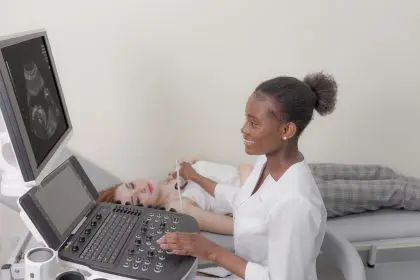Finding a lump or experiencing changes in your breast naturally triggers worry about cancer. The good news? Most breast changes, including lumps, pain, and nipple discharge, turn out to be benign conditions. Understanding these non-cancerous alternatives can help alleviate unnecessary anxiety while ensuring you take appropriate action for your health.
The importance of proper breast evaluation
When breast symptoms appear, distinguishing between benign conditions and potential cancer requires professional assessment. While most breast changes don’t indicate cancer, proper evaluation ensures accurate diagnosis and appropriate care.
The evaluation process typically begins with a clinical breast exam, where a healthcare provider examines the breast tissue for abnormalities. Depending on findings, your age, and risk factors, imaging tests may follow. Mammograms remain the primary screening tool, while ultrasounds often provide additional information, especially in younger women with dense breast tissue.
For concerning findings, a biopsy may be recommended. This procedure removes a small tissue sample for laboratory examination – the only definitive way to determine if cells are cancerous or benign. The waiting period between tests and results often causes significant anxiety, but understanding potential benign explanations for your symptoms may provide some reassurance during this time.
Fibrocystic breast changes
Fibrocystic changes represent the most common benign breast condition, affecting over half of women at some point. This condition involves the development of fluid-filled cysts and fibrous tissue that can cause breast lumpiness, tenderness, and sometimes pain.
The lumps associated with fibrocystic changes typically feel round, mobile, and sometimes tender. They often fluctuate with hormonal cycles, becoming more prominent and painful before menstruation and improving afterward. Multiple lumps may appear in both breasts rather than a single, fixed mass.
Hormonal fluctuations drive these changes, which explains why symptoms often worsen before periods and improve after menopause. While fibrocystic changes don’t increase cancer risk, they can make breast examination more challenging, potentially masking other changes.
Management typically focuses on symptom relief rather than medical intervention. Wearing supportive bras, reducing caffeine intake, and using over-the-counter pain relievers often help manage discomfort. For severe symptoms, hormonal medications sometimes provide relief.
Fibroadenomas and their variations
Fibroadenomas appear as solid, smooth, firm breast lumps that move easily when touched – often described as feeling like a marble within the breast tissue. These common benign tumors typically affect women in their 20s and 30s but can develop at any age.
Most fibroadenomas remain small, measuring 1-3 centimeters, though some grow larger or shrink over time. They rarely cause pain but might feel tender during menstruation due to hormonal changes. While a single fibroadenoma represents the most common presentation, some women develop multiple masses.
Several fibroadenoma variants exist, including juvenile fibroadenomas, which develop during adolescence and sometimes grow rapidly, and giant fibroadenomas, which exceed 5 centimeters. Complex fibroadenomas contain additional tissue elements that slightly increase future breast cancer risk, though the increase remains small.
Management depends on factors including size, growth pattern, symptoms, and personal preference. Small, asymptomatic fibroadenomas confirmed by biopsy often require only monitoring. Larger or growing fibroadenomas might be surgically removed, as might those causing discomfort or anxiety.
Breast cysts and their characteristics
Breast cysts develop when fluid accumulates within breast glands, creating fluid-filled sacs that can appear suddenly and sometimes grow quickly. These common benign findings affect many women, particularly those between 35 and 50.
Simple cysts typically feel round, smooth, and mobile – sometimes tender to touch, especially before menstruation. They can vary significantly in size, from barely detectable to several centimeters across. Some women develop a single cyst, while others experience multiple cysts in one or both breasts.
Ultrasound distinguishes fluid-filled cysts from solid masses with high accuracy. Simple cysts appear as well-defined, dark areas with specific sound transmission characteristics. For confirmation or symptom relief, fluid aspiration using a fine needle provides both diagnostic information and treatment.
Most breast cysts resolve spontaneously over time or after fluid aspiration. Recurrence happens in some women, particularly those with multiple cysts. When cysts cause significant discomfort, treatment options include aspiration for immediate relief or hormonal medications to reduce formation.
Mastitis and breast infections
Breast infections cause symptoms that sometimes mimic inflammatory breast cancer, including breast redness, warmth, pain, and swelling. Most commonly affecting breastfeeding women, these infections can also occur in non-lactating women and, rarely, in men.
Lactational mastitis develops when bacteria enter breast tissue, typically through cracked nipples during breastfeeding. The affected area becomes red, swollen, tender, and warm to touch. Systemic symptoms often include fever, chills, and fatigue. Prompt treatment prevents abscess formation.
Non-lactational mastitis occurs less frequently but follows similar patterns. Risk factors include smoking, diabetes, steroid use, and certain skin conditions. Subareolar abscesses specifically affect the tissue beneath the areola, sometimes related to blocked ducts.
Periductal mastitis involves inflammation of the ducts beneath the nipple, potentially leading to nipple retraction – a finding also associated with breast cancer. This condition occurs more frequently in smokers due to damage to the ducts near the nipple.
Antibiotics effectively treat most breast infections when started promptly. Continued breastfeeding (or pumping) from the affected breast helps clear blocked ducts. Warm compresses and anti-inflammatory medications provide symptom relief. For abscesses, drainage procedures may become necessary.
Intraductal papillomas and nipple discharge
Intraductal papillomas develop within the milk ducts, typically near the nipple. These small, wart-like growths frequently cause bloody or clear nipple discharge – a symptom that commonly raises cancer concerns.
The discharge associated with papillomas typically comes from a single duct in one breast, unlike the multiple-duct discharge seen with hormonal causes. The discharge may appear spontaneously or only with nipple stimulation. While often clear or bloody, the discharge might also appear yellow, green, or brown.
Besides discharge, some women experience a small, palpable lump near the areola. Pain occurs in approximately one-third of cases, typically described as burning or itching sensations near the nipple rather than deep breast pain.
Diagnostic evaluation includes imaging and often ductography, where contrast material injected into the affected duct helps visualize the papilloma. Surgical excision provides both diagnosis and treatment, removing the papilloma and a portion of the affected duct.
Most intraductal papillomas prove entirely benign. However, certain variants with atypical cells may slightly increase breast cancer risk. After removal, recurrence remains uncommon, though some women develop new papillomas in different ducts.
Fat necrosis and its presentation
Fat necrosis develops when breast fat tissue dies, typically following trauma, surgery, or radiation therapy. The resulting scar tissue can form a firm lump that mimics cancer on both physical examination and imaging studies.
The lumps associated with fat necrosis typically feel firm, irregular, and sometimes tender – characteristics shared with cancerous masses. Unlike many benign conditions, these lumps don’t move easily within the breast and may appear attached to surrounding tissue.
Oil cysts sometimes form within areas of fat necrosis, creating round, fluid-filled sacs containing liquefied fat. These cysts feel smooth and well-defined compared to the irregular texture of fat necrosis itself.
On mammograms, fat necrosis can produce suspicious findings, including irregular masses and microcalcifications similar to those seen in breast cancer. This similarity often necessitates biopsy for definitive diagnosis, despite a known history of trauma or surgery.
Most cases require no specific treatment once a definitive benign diagnosis confirms fat necrosis. The masses may remain stable, shrink, or disappear entirely over months to years. Surgical removal sometimes becomes necessary when the diagnosis remains uncertain or when the mass causes significant symptoms or anxiety.
When benign conditions require monitoring
While benign breast conditions don’t threaten life the way cancer does, some warrant ongoing surveillance due to their association with slightly increased cancer risk.
Atypical hyperplasia, characterized by abnormal cell growth patterns, increases breast cancer risk approximately four-fold. This condition typically produces no symptoms and appears as microcalcifications on mammograms. Regular imaging, possibly supplemented by MRI, enables early detection of any concerning changes.
Radial scars, despite their name, don’t result from scarring but rather form star-shaped lesions visible on imaging. These lesions slightly increase cancer risk and sometimes coexist with atypical cells or early cancers, necessitating careful monitoring or sometimes surgical removal.
Complex sclerosing lesions resemble radial scars but contain additional tissue elements. Their appearance on imaging often raises concern, typically leading to biopsy. Once confirmed benign, monitoring continues due to their slight association with increased cancer risk.
Flat epithelial atypia involves abnormal cells lining the terminal ducts. When found during biopsy for other reasons, this condition warrants close follow-up due to its association with both atypical hyperplasia and low-grade pre-cancerous changes.
Taking control of breast health
Understanding benign breast conditions empowers you to approach breast changes with appropriate concern rather than undue anxiety. Several strategies help maintain breast health while ensuring prompt attention to potentially significant changes.
Familiarize yourself with your normal breast tissue through regular self-awareness. While formal monthly self-examinations have fallen out of favor, knowing your breast’s typical appearance and feel helps you recognize changes promptly.
Follow age-appropriate screening guidelines based on your personal risk factors. The general recommendation for women at average risk includes annual mammograms starting at age 40, though guidelines vary among organizations. Women with higher risk may benefit from earlier or additional screening methods.
Report breast changes promptly rather than monitoring at home. Changes warranting evaluation include new lumps, persistent pain, nipple discharge or retraction, skin changes, and asymmetry between breasts.
Maintain perspective when breast symptoms develop. Remember that over 80% of breast biopsies yield benign results, and most breast symptoms stem from normal physiological changes or benign conditions rather than cancer.
By balancing appropriate vigilance with realistic understanding of benign breast conditions, you can protect your breast health without unnecessary anxiety over every breast change.












